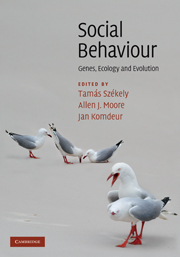Book contents
- Frontmatter
- Contents
- List of contributors
- Introduction: The uphill climb of sociobiology: towards a new synthesis
- Profile: Undiminished passion
- Part I Foundations
- Part II Themes
- 7 Aggression: towards an integration of gene, brain and behaviour
- Profile: From behavioural observations, to genes, to evolution
- 8 Social influences on communication signals: from honesty to exploitation
- Profile: Reputation can make the world go round – or why we are sometimes social
- 9 Important topics in group living
- Profile: A haphazard career
- 10 Sexual behaviour: conflict, cooperation and coevolution
- Profile: In celebration of questions, past, present and future
- 11 Pair bonds and parental behaviour
- Profile: Mating systems and genetic variation
- 12 Adaptations and constraints in the evolution of delayed dispersal: implications for cooperation
- Profile: Selections from a life in social selection
- 13 Social behaviour in microorganisms
- Profile: The de novo evolution of cooperation: an unlikely event
- 14 Social environments, social tactics and their fitness consequences in complex mammalian societies
- Profile: Evolutionary genetics and social behaviour: changed perspectives on sexual coevolution
- 15 Social behaviour in humans
- Profile: Genes and social behaviour: from gene to genome to 1000 genomes
- Part III Implications
- Species index
- Subject index
- References
12 - Adaptations and constraints in the evolution of delayed dispersal: implications for cooperation
Published online by Cambridge University Press: 05 June 2012
- Frontmatter
- Contents
- List of contributors
- Introduction: The uphill climb of sociobiology: towards a new synthesis
- Profile: Undiminished passion
- Part I Foundations
- Part II Themes
- 7 Aggression: towards an integration of gene, brain and behaviour
- Profile: From behavioural observations, to genes, to evolution
- 8 Social influences on communication signals: from honesty to exploitation
- Profile: Reputation can make the world go round – or why we are sometimes social
- 9 Important topics in group living
- Profile: A haphazard career
- 10 Sexual behaviour: conflict, cooperation and coevolution
- Profile: In celebration of questions, past, present and future
- 11 Pair bonds and parental behaviour
- Profile: Mating systems and genetic variation
- 12 Adaptations and constraints in the evolution of delayed dispersal: implications for cooperation
- Profile: Selections from a life in social selection
- 13 Social behaviour in microorganisms
- Profile: The de novo evolution of cooperation: an unlikely event
- 14 Social environments, social tactics and their fitness consequences in complex mammalian societies
- Profile: Evolutionary genetics and social behaviour: changed perspectives on sexual coevolution
- 15 Social behaviour in humans
- Profile: Genes and social behaviour: from gene to genome to 1000 genomes
- Part III Implications
- Species index
- Subject index
- References
Summary
Overview
Cooperation is a ubiquitous feature of life. While many instances of cooperation are explicable as the selfish motives of individuals, other forms of cooperation, such as cooperative breeding in which individuals live and breed in mixed-sex groups of three or more adults and share in providing care at a single breeding attempt, are difficult to explain. Given that the majority of cooperative breeders exhibit delayed dispersal, it would appear that delayed dispersal plays a role in the evolution of cooperative breeding. However, there are several species that, despite the absence of cooperative breeding, live in family units. Thus it is important to understand the specific fitness consequences of delayed dispersal independently of the confounding fitness consequences of helping behaviour.
In this chapter we focus on how delayed dispersal has evolved or can be maintained in the absence of cooperative breeding. We do this by exploring the proximate and ultimate factors involved in the evolution of delayed dispersal in species which exhibit delayed dispersal but do not cooperate by helping to raise non-descendant relatives. We show that the benefits of delaying dispersal and being philopatric to maintain a family association can come either as direct fitness gained through enhanced survival in family groups (e.g. better predator defence or food access) and/or enhanced future reproduction. Survival benefits from cooperation among group-living kin are likely to be a more general candidate of a fitness component selecting for family cohesion than the inclusive fitness gains from alloparental care.
- Type
- Chapter
- Information
- Social BehaviourGenes, Ecology and Evolution, pp. 306 - 327Publisher: Cambridge University PressPrint publication year: 2010
References
- 9
- Cited by



